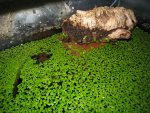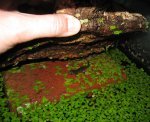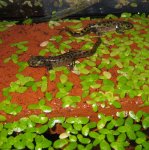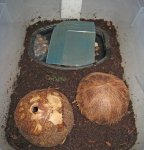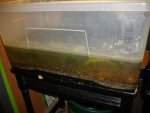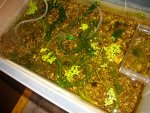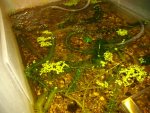Here is the tank I have used for raising Triturus marmoratus larvae. This type of setup could be used for a variety of species. It is a 15-gallon and I have raised up to about 25 larvae in this tank.
The eggs were placed directly in the tank. After hatching, the larvae were difficult to see, but I kept them with a supply of small daphnia. Also I'm sure they grazed on the natural microinvertebrates that live in a well-established planted tank. Until they get large enough to see, this process is a bit of a "flying blind" experience, but the larvae always end up healthy.
The bottom of the tank is bare, except for algae. I have minimized flat objects in the bottom of the tank so that the blackworms cannot hide too well.
When they morph, the metamorphs emerge onto the flat island. The cork bark is there so that they feel safe on land, in the hopes that they are less likely to dive back in and drown. After they emerge, I move them to a terrestrial setup, which is shown in the last photo.
The eggs were placed directly in the tank. After hatching, the larvae were difficult to see, but I kept them with a supply of small daphnia. Also I'm sure they grazed on the natural microinvertebrates that live in a well-established planted tank. Until they get large enough to see, this process is a bit of a "flying blind" experience, but the larvae always end up healthy.
The bottom of the tank is bare, except for algae. I have minimized flat objects in the bottom of the tank so that the blackworms cannot hide too well.
When they morph, the metamorphs emerge onto the flat island. The cork bark is there so that they feel safe on land, in the hopes that they are less likely to dive back in and drown. After they emerge, I move them to a terrestrial setup, which is shown in the last photo.


